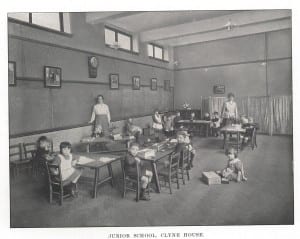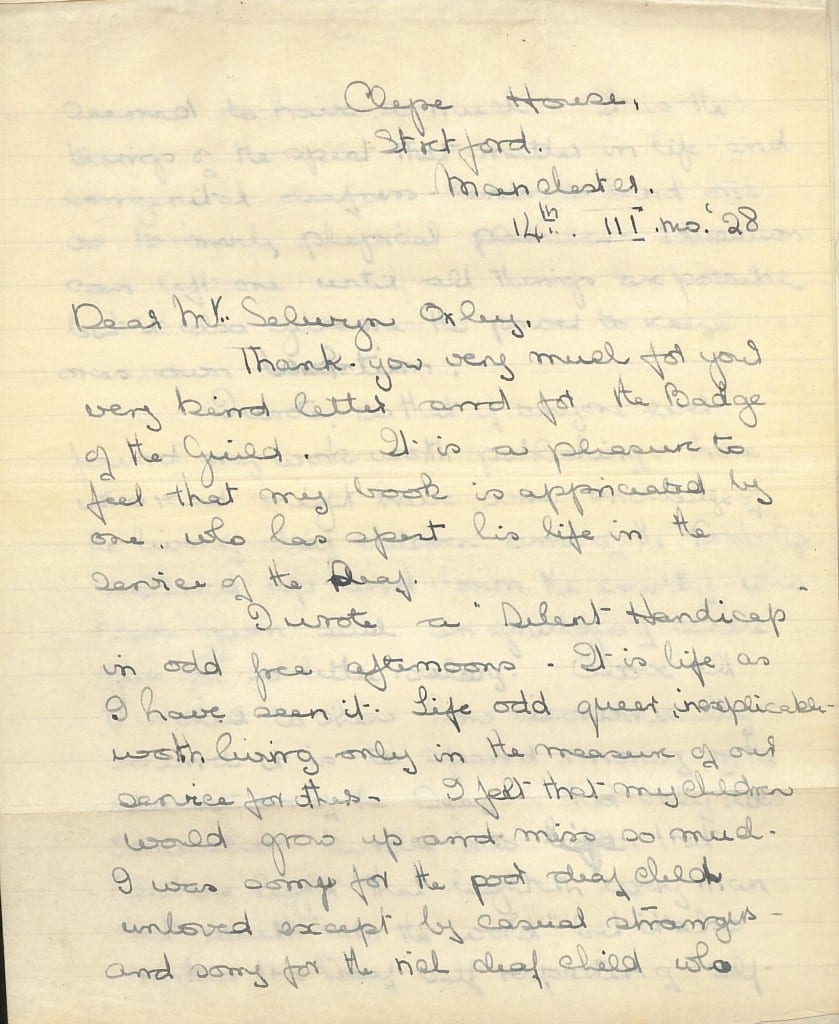“His lips sought her skin as the horse noses its mate. […] It was a strange proposal of marriage.”
By H Dominic W Stiles, on 17 March 2016
 Ann Denman was the nome de plume of Katie E.M. Croft, a teacher of the deaf at the Royal School for the Deaf, Manchester. I cannot add any interesting biographical details about her as I have not definitely identified her date or place of birth or death, though it is possible she is Katharine Elizabeth M. Croft, born in Derby in 1895. Unfortunately we do not have a complete record of the Royal School annual reports, which were very full and included pictures. Miss Croft appears on the list of staff for Clyne House, the part of the Royal School for the juniors, under nines, from at least 1925 to the war. She was one of the resident teachers, following on from the first resident teacher at the school, Irene Goldsack, who married Alexander Ewing.
Ann Denman was the nome de plume of Katie E.M. Croft, a teacher of the deaf at the Royal School for the Deaf, Manchester. I cannot add any interesting biographical details about her as I have not definitely identified her date or place of birth or death, though it is possible she is Katharine Elizabeth M. Croft, born in Derby in 1895. Unfortunately we do not have a complete record of the Royal School annual reports, which were very full and included pictures. Miss Croft appears on the list of staff for Clyne House, the part of the Royal School for the juniors, under nines, from at least 1925 to the war. She was one of the resident teachers, following on from the first resident teacher at the school, Irene Goldsack, who married Alexander Ewing.
Why are we particularly interested in her rather than Misses Elliott, Baker or Cross, her fellow teachers in 1925? Well, she wrote a novel, A Silent Handicap, published by Edward Arnold in 1927. The novel follows the lives of three children who were born deaf, an illegitimate orphaned girl, a boy from a poor background, and a girl with wealthy parents. Our copy has a promotional leaflet with review excerpts, and Selwyn Oxley’s inimitable black inky scrawl. He had a brief correspondence with Katie Croft, which is stuck into the front of the book. First there is a three page letter from the 14th of March, 1928, then a couple of short notes congratulating the Oxley’s on their marriage, and Kate Oxley’s second book being published. Oxley had sent her a Guild of St. John of Beverley badge. He seems to have scattered them around, for I have come across other mentions of people receiving one.
He had a brief correspondence with Katie Croft, which is stuck into the front of the book. First there is a three page letter from the 14th of March, 1928, then a couple of short notes congratulating the Oxley’s on their marriage, and Kate Oxley’s second book being published. Oxley had sent her a Guild of St. John of Beverley badge. He seems to have scattered them around, for I have come across other mentions of people receiving one.
A few quotations from the novel will give a flavour of the story.
“She’s deaf and dumb, you know,” said Mr. Searle, feeling sorry for the woman and the child.
“Fiddlesticks!” said the Doctor. “You can train a puppy, why not a deaf child? […]” (p.8)
School work began with prayers. Geoff stood sullenly between two children. A grown-up person had pushed him there and shaken her finger at him, and as he had always associated a sound cuff with the breaking of the law as laid down by finger-waggers, he stood where he had been put and frowned angrily. (p.30)
Chapter 19, A Proposal, describes how Mary and Geoff, the two children in the excerpts above now adults, get engaged: Geoff has given Mary a watch as a present –
Her eyes sparkled. She looked up at Geoff to thank him. He did not wait for her thanks, but caught her in his arms, and rubbed his mouth against her neck and cheek. He had never learnt to kiss. His lips sought her skin as the horse noses its mate. Mary bent back her head that their faces might meet. She rubbed her cheek against his.
It was a strange proposal of marriage. (p.194)
This was the 1920s, and eugenics rears its head –
“You should say until Prince Charming comes,” said her father. […] He’ll be coming along and marrying you.”
“Marry me? No one will ever marry me, said Sally, shaking her pretty head. I shall not marry , Daddy. I shall live for ever and ever with you.”
“I wish I could think so, but I can’t,” said Sir Patrick.
“Yes, I shall,” said Sally. She had been reading a book on eugenics, and spoke with the finality of youth. “Deaf people shouldn’t marry.”[…]
“Love and common sense don’t go together, Sally,” he said, but Sally had stooped to get a piece of coal from the box, and had not seen him speak. (p.231)
Katie Croft says in her letter to Oxley,
I wrote a “Silent Handicap” in odd free afternoons. It is life as I have seen it. Life odd queer, inexplicable – worth living only in the measure of service for others. I felt that my children would grow up and miss so much. I was sorry for the poor deaf child unloved except by casual strangers – and sorry for the rich deaf child who seemed to have so much. It is the things of the spirit that matter in life – and congenital deafness tends to bind one so to mainly physical pleasures. Education can lift one until all things are possible but it also gives the power to realize ones own isolation.
I wrote, so that if anyone ever found my work worth publishing, those who read might have some knowledge of the lives of deaf children, and of the “Dockerty’s”* scattered up and down the country, who have given such ungrudging service often for so little salary. Above all I wished to show how economically sound it is to spend money on the education of the Deaf. Not only does education kindle into life that Divine “light that lighteth every man that cometh into the world” but it also makes the Deaf self respecting, self supporting citizens: a help not a drag upon the community.
 If you can add any information about Katie Croft, please do in the comments field below. The novel is probably hard to find – at the time of writing there is one available on Alibris. We have a loan copy as well as the one with the letters.
If you can add any information about Katie Croft, please do in the comments field below. The novel is probably hard to find – at the time of writing there is one available on Alibris. We have a loan copy as well as the one with the letters.
For a picture of Clyne House search here https://apps.trafford.gov.uk/TraffordLifetimes.
It seems that the house was a hospital during the Great War.
*Dockerty was a character in the novel
Thanks to Geoff Eagling for the update below.
2 Responses to ““His lips sought her skin as the horse noses its mate. […] It was a strange proposal of marriage.””
- 1
-
2
Edward Baines wrote on 25 October 2019:
I was fascinated by this piece, as I’m both a current trustee/director of Seashell Trust, which includes Royal School, Manchester ( see www,seashelltrust.org.uk) and have just written a short history of the charity founded 1823. For the bicentenary I’ve agreed to research material for a book. By coincidence our Chair of Trustees, Gwen Carr, Hon Senior Research Associate / UCL Ear Institute, is at UCL next week.
I have access to the full Annual Reports, but have initially found that she was as you and Mr Eagling suspected the lady born in Derby in 1895. In 1939 she was still a Teacher of the Deaf living close to the School at 113, Cromwell Road, Stretford, Manchester. However, in 1944 she married a James Riley in Leicester and died on 3rd July 1978 in Wolverhampton leaving an estate in excess of £32,000. Currently, I think her story is worthy of further research .
Regards, Ed Baines
 Close
Close


Katherine Elizabeth MacDonald Croft gained her Teacher of the Deaf Certificate in Manchester (presumably Victoria University of Manchester, Deaf Education Dept.) in 1920.
Source: Register of Graduates and Holders of Diplomas and Certificates 1851-1958.
Published by Manchester University Press.